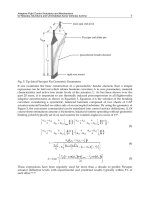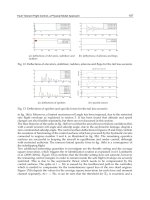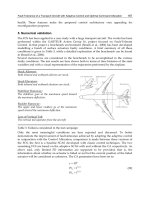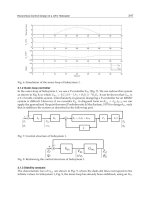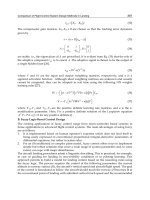Advances in Human Robot Interaction Part 1 doc
Bạn đang xem bản rút gọn của tài liệu. Xem và tải ngay bản đầy đủ của tài liệu tại đây (1.17 MB, 25 trang )
Advances in Human-Robot Interaction
Advances in Human-Robot Interaction
Edited by
Vladimir A. Kulyukin
I-Tech
IV
Published by In-Teh
In-Teh
Olajnica 19/2, 32000 Vukovar, Croatia
Abstracting and non-profit use of the material is permitted with credit to the source. Statements and
opinions expressed in the chapters are these of the individual contributors and not necessarily those of
the editors or publisher. No responsibility is accepted for the accuracy of information contained in the
published articles. Publisher assumes no responsibility liability for any damage or injury to persons or
property arising out of the use of any materials, instructions, methods or ideas contained inside. After
this work has been published by the In-Teh, authors have the right to republish it, in whole or part, in
any publication of which they are an author or editor, and the make other personal use of the work.
© 2009 In-teh
www.in-teh.org
Additional copies can be obtained from:
First published December 2009
Printed in India
Technical Editor: Teodora Smiljanic
Advances in Human-Robot Interaction, Edited by Vladimir A. Kulyukin
p. cm.
ISBN 978-953-307-020-9
Preface
Rapid advances in the field of robotics have made it possible to use robots not just in
industrial automation but also in entertainment, rehabilitation, and home service. Since
robots will likely affect many aspects of human existence, fundamental questions of human-
robot interaction must be formulated and, if at all possible, resolved. Some of these
questions are addressed in this collection of papers by leading HRI researchers.
Readers may take several paths through the book. Those who are interested in personal
robots may wish to read Chapters 1, 4, and 7. Multi-modal interfaces are discussed in
Chapters 1 and 14. Readers who wish to learn more about knowledge engineering and
sensors may want to take a look at Chapters 2 and 3. Emotional modeling is covered in
Chapters 4, 8, 9, 16, 18. Various approaches to socially interactive robots and service robots
are offered and evaluated in Chapters 7, 9, 13, 14, 16, 18, 20. Chapter 5 is devoted to smart
environments and ubiquitous computing. Chapter 6 focuses on multi-robot systems.
Android robots are the topic of Chapters 8 and 12. Chapters 6, 10, 11, 15 discuss
performance measurements. Chapters 10 and 12 may be beneficial to readers interested in
human motion modeling. Haptic and natural language interfaces are the topics of Chapters
11 and 14, respectively. Military robotics is discussed in Chapter 15. Chapter 17 is on
cognitive modeling. Chapter 19 focuses on robot navigation. Chapters 13 and 20 cover
several HRI issues in assistive technology and rehabilitation. For convenience of reference,
each chapter is briefly summarized below.
In Chapter 1, Mamiko Sakata, Mieko Marumo, and Kozaburo Hachimura contribute to
the investigation of non-verbal communication with personal robots. The objective of their
research is the study of the mechanisms to express personality through body motions and
the classification of motion types that personal robots should be given in order to make
them express specific personality or emotional impressions. The researchers employ motion-
capturing techniques for obtaining human body movements from the motions of Nihon-
buyo, a traditional Japanese dance. They argue that dance, as a motion form, allows for
more artistic body motions compared to everyday human body motions and makes it easier
to discriminate emotional factors that personal robots should be capable of displaying in the
future.
In Chapter 2, Atilla Elçi and Behnam Rahnama address the problem of giving
autonomous robots a sense of self, immediate ambience, and mission. Specific techniques
are discussed to endow robots with self-localization, detection and correction of course
deviation errors, faster and more reliable identification of friend or foe, simultaneous
localization and mapping in unfamiliar environments. The researchers argue that advanced
VI
robots should be able to reason about the environments in which they operate. They
introduce the concept of Semantic Intelligence (SI) and attempt to distinguish it from
traditional AI.
In Chapter 3, Xianming Ye, Byungjune Choi, Hyouk Ryeol Choi, and Sungchul Kang
propose a compact handheld pen-type texture sensor for the measurement of fine texture.
The proposed texture sensor is designed with a metal contact probe and can measure the
roughness and frictional properties of a surface. The sensor reduces the size of contact area
and separates the normal stimuli from tangential ones, which facilitates the interpretation of
the relation between dynamic responses and the surface texture. 3D contact forces can be
used to estimate the surface profile in the path of exploration.
In Chapter 4, Sébastien Saint-Aimé, Brigitte Le-Pévédic, and Dominique Duhaut
investigate the question of how to create robots capable of behavior enhancement through
interaction with humans. They propose the minimal number of degrees of freedom
necessary for a companion robot to express six primary emotions. They propose iCrace, a
computational model of emotional reasoning, and describe experiments to validate several
hypotheses about the length and speed of robotic expressions, methods of information
processing, response consistency, and emotion recognition.
In Chapter 5, Takeshi Sasaki, Yoshihisa Toshima, Mihoko Niitsuma and Hideki
Hashimoto investigate how human users can interact with smart environments or, as they
call them, iSpaces (intelligent spaces). They propose two human-iSpace interfaces – a spatial
memory and a whistle interface. The spatial memory uses three-dimensional positions.
When a user specifies digital information that indicates a position in the space, the system
associates the 3D position with that information. The whistle interface uses the frequency of
a human whistling as a trigger to call a service. This interface is claimed to work well in
noisy environments, because whistles are easily detectable. They describe an information
display system using a pan-tilt projector. The system consists of a projector and a pan-tilt
enabled stand. The system can project an image toward any position. They present
experimental results with the developed system.
In Chapter 6, Jijun Wang and Michael Lewis presents an extension of Crandall's Neglect
Tolerance model. Neglect tolerance estimates a period of time when human intervention
ends but before a performance measure drops below an acceptable threshold. In this period,
the operator can perform other tasks. If the operator works with other robots over this time
period neglect tolerance can be extended to estimate the overall number of robots under the
operator's control. The researchers' main objective is to develop a computational model that
accommodates both coordination demands and heterogeneity in robotic teams. They
present an extension of Neglect Tolerance model in section and a multi-robot system
simulator that they used in validation experiments. The experiments attempt to measure
coordination demand under strong and weak cooperation conditions.
In Chapter 7, Kazuki Kobayashi and Seiji Yamada consider the situation in which a
human cooperates with a service robot, such as a sweeping robot or a pet robot. Service
robots often need users' assistance when they encounter difficulties that they cannot
overcome independently. One example given in this chapter is a sweeping robot unable to
navigate around a table or a chair and needing the user’s assistance to move the obstacle out
of its way. The problem is how to enable a robot to inform its user that it needs help. They
propose a novel method for making a robot to express its internal state (referred to as robot's
mind) to request users' help. Robots can express their minds both verbally and non-verbally.
VII
The proposed non-verbal expression centers around movement based on motion overlap
(MO) that enables the robot to move in a way that the user narrows down possible
responses and acts appropriately. The researchers describe an implementation on a real
mobile robot and discuss experiments with participants to evaluate the implementation's
effectiveness.
In Chapter 8, Takashi Minato and Hiroshi Ishiguro present a study human-like robotic
motion during interaction with other people. They experiment with an android endowed
with motion variety. They hypothesize that if a person attributes a cause of motion variety
in an android to the android's mental states, physical states, and the social situations, the
person has more humanlike impression toward the android. Their chapter focuses on
intentional motion caused by the social relationship between two agents. They consider the
specific case when one agent reaches out and touches another person. They present a
psychological experiment in which participants watch an android touch a human or an
object and report their impressions.
In Chapter 9, Kazuhiro Taniguchi, Atsushi Nishikawa, Tomohiro Sugino, Sayaka
Aoyagi, Mitsugu Sekimoto, Shuji Takiguchi, Kazuyuki Okada, Morito Monden, and Fumio
Miyazaki propose a method for objectively evaluating psychological stress in humans who
interact with robots. The researchers argue that there is a large disparity between the image
of robots from popular fiction and their actual appearance in real life. Therefore, to facilitate
human-robot interaction, we need not only to improve the robot's physical and intellectual
abilities but also find effective ways of evaluating the psychological stress experienced by
humans when they interact with robots. The authors evaluate human stress with
acceleration pulse waveforms and saliva constituents of a surgeon using a surgical assistant
robot.
In Chapter 10, Woong Choi, Tadao Isaka, Hiroyuki Sekiguchi, and Kozaburo
Hachimura give a quantitative analysis of leg movements. They use simultaneous
measurements of body motion and electromyograms to assess biophysical information. The
investigators used two expert Japanese traditional dancers as subjects of their experiments.
The experiments show that a more experienced dancer has the effective co-contraction of
antagonistic muscles of the knee and ankle and less center of gravity transfer than a less
experienced dancer. An observation is made that the more experienced dancer can
efficiently perform dance leg movements with less electromyogramic activity than the less
experienced counterpart.
In Chapter 11, Tsuneo Yoshikawa, Masanao Koeda and Munetaka Sugihashi propose to
define handedness as an important factor in designing tools and devices that are to be
handled by people using their hands. The researchers propose a quantitative method for
evaluating quantitatively the handedness and dexterity of a person on the basis of the
person's performance in test tasks (accurate positioning, accurate force control, and skillful
manipulation) in the virtual world by using haptic virtual reality technology. Factor scores
are obtained for the right and left hands of each subject and the subject's degree of
handedness is defined as the difference of these factor scores. The investigators evaluated
the proposed method with ten subjects and found that it was consistent with the
measurements obtained from the traditional laterality quotient method.
In Chapter 12, Tomoo Takeguchi, Minako Ohashi and Jaeho Kim argue that service
robots may have to walk along with humans for special care. In this situation, a robot must
be able to walk like a human and to sense how the human walks. The researchers analyze
VIII
3D walking with rolling motion. The 3D modeling and simulation analysis were performed
to find better walking conditions and structural parameters. The investigators describe a 3D
passive dynamic walker that was manufactured to analyze the passive dynamic walking
experimentally.
In Chapter 13, Yasuhisa Hirata, Takuya Iwano, Masaya Tajika and Kazuhiro Kosuge
propose a wearable walking support system, called Wearable Walking Helper, which is
capable of supporting walking activity without using biological signals. The support
moment of the joints of the user is computed by the system using an approximated human
model of four-link open chain mechanism on the sagittal plane. The system consists of knee
orthosis, prismatic actuator, and various sensors. The knee joint of the orthosis has one
degree of freedom and rotates around the center of the knee joint of the user on sagittal
plane. The knee joint is a geared dual hinge joint. The prismatic actuator includes a DC
motor and a ball screw. The device generates support moment around the user's knee joint.
In Chapter 14, Tetsushi Oka introduces the concept of a multimodal command
language to direct home-use robots. The author introduces RUNA (Robot Users' Natural
Command Language). RUNA is a multimodal command language for directing home-use
robots. It is designed to allow the user to robots by using hand gestures or pressing remote
control buttons. The language consists of grammar rules and words for spoken commands
based on the Japanese language. It also includes non-verbal events, such as touch actions,
button press actions, and single-hand and double-hand gestures. The proposed command
language is sufficiently flexible in that the user can specify action types (walk, turn,
switchon, push, and moveto) and action parameters (speed, direction, device, and goal) by
using both spoken words and nonverbal messages.
In Chapter 15, Jessie Chen examines if and how aided target recognition (AiTR) cueing
capabilities facilitate multitasking (including operating a robot) by gunners in a military
tank crew station environment. The author investigates if gunners can perform their
primary task of maintaining local security while they are performing two secondary tasks of
managing a robot and communicating with fellow crew members. Two simulating
experiments are presented. The findings suggest reliable automation, such as AiTR, for one
task benefits not only the automated task but also the concurrent tasks.
In Chapter 16, Eun-Sook Jee, Yong-Jeon Cheong, Chong Hui Kim, Dong-Soo Kwon, and
Hisato Kobayashi investigate the process of emotional sound production in order to enable
robots to express emotion effectively and to facilitate the interaction between humans and
robots. They use the explicit or implicit link between emotional characteristics and musical
parameters to compose six emotional sounds: happiness, sadness, fear, joy, shyness, and
irritation. The sounds are analyzed to identify a method to improve a robot's emotional
expressiveness. To synchronize emotional sounds with robotic movements and gestures, the
emotional sounds are divided into several segments in accordance with musical structure.
The researchers argue that the existence of repeatable sound segments enable robots to
better synchronize their behaviors with sounds.
In Chapter 17, Eiji Hayashi discusses a Consciousness-based Architecture (CBA) that
has been synthesized based on a mechanistic expression model of animal consciousness and
behavior advocated by the Vietnamese philosopher Tran Duc Thao. CBA has an evaluation
function for behavior selection and controls the agent's behavior. The author argues that it is
difficult for a robot to behave autonomously if the robot relies exclusively on the CBA. To
achieve such autonomous behavior, it is necessary to continuously produce behavior in the
IX
robot and to change the robot's consciousness level. The research proposes a motivation
model to induce conscious, autonomous changes in behavior. The model is combined with
the CBA. The motivation model serves an input to the CBA. The modified CBA was
implemented in a Conscious Behavior Robot (Conbe-I). The Conbe-I is a robotic arm with a
hand consisting of three fingers in which a small monocular CCD camera is installed. A
study of the robot's behavior is presented.
In Chapter 18, Anja Austermann and Seiji Yamada argue that learning robots can use
the feedback from their users as a basis for learning and adapting to their users' preferences.
The researchers investigate how to enable a robot to learn to understand natural,
multimodal approving or disapproving feedback given in response to the robot's moves.
They present and evaluate a method for learning a user's feedback for human-robot
interaction. Feedback from the user comes in the form of speech, prosody, and touch. These
types of feedback are found to be sufficiently reliable for teaching a robot by reinforcement
learning.
In Chapter 19, Kohji Kamejima introduces fractal representation of the maneuvering
affordance on the randomness ineluctably distributed in naturally complex scenes. The
author describes a method to extract scale shift of random patterns from scene image and to
match it to the a priori direction of a roadway. Based on scale space analysis, the probability
of capturing not-yet-identified fractal attractors is generated within the roadway pattern to
be detected. Such an in-situ design process yields anticipative models for road following
process. The randomness-based approach yields a design framework for machine
perception sharing man-readable information, i.e., natural complexity of textures and
chromatic distributions.
In Chapter 20, Vladimir Kulyukin and Chaitanya Gharpure describe their work on
robot-assisted shopping for the blind and visually impaired. In their previous research, the
researchers developed RoboCart, a robotic shopping cart for the visually impaired. The
researchers focus on how blind shoppers can select a product from the repository of
thousands of products, thereby communicating the target destination to RobotCart. This
task becomes time critical in opportunistic grocery shopping when the shopper does not
have a prepared list of products. Three intent communication modalities (typing, speech,
and browsing) are evaluated in experiments with 5 blind and 5 sighted, blindfolded
participants on a public online database of 11,147 household products. The mean selection
time differed significantly among the three modalities, but the modality differences did not
vary significantly between blind and sighted, blindfolded groups, nor among individual
participants.
Editor
Vladimir A. Kulyukin
Department of Computer Science,
Utah State University
USA
Contents
Preface V
1. Motion Feature Quantification of Different Roles in Nihon-Buyo Dance 001
Mamiko Sakata, Mieko Marumo, and Kozaburo Hachimura
2. Towards Semantically Intelligent Robots 013
Atilla Elçi and Behnam Rahnama
3. Pen-type Sensor for Surface Texture Perception 039
Xianming Ye, Byungjune Choi, Hyouk Ryeol Choi, and Sungchul Kang
4. iGrace – Emotional Computational Model for EmI Companion Robot. 051
Sébastien Saint-Aimé and Brigitte Le-Pévédic and Dominique Duhaut
5. Human System Interaction through
Distributed Devices in Intelligent Space
077
Takeshi Sasaki, Yoshihisa Toshima, Mihoko Niitsuma and Hideki Hashimoto
6. Coordination Demand in Human Control of Heterogeneous Robot 91
Jijun Wang and Michael Lewis
7. Making a Mobile Robot to Express its Mind by Motion Overlap 111
Kazuki Kobayashi
and Seiji Yamada
8. Generating Natural Interactive Motion
in Android Based on Situation-Dependent Motion Variety
125
Takashi Minato and Hiroshi Ishiguro
9. Method for Objectively Evaluating Psychological Stress Resulting
when Humans Interact with Robots
141
Kazuhiro Taniguchi, Atsushi Nishikawa, Tomohiro Sugino,
Sayaka Aoyagi, Mitsugu Sekimoto, Shuji Takiguchi, Kazuyuki Okada,
Morito Monden and Fumio Miyazaki
XII
10. Quantitative Analysis of Leg Movement and EMG signal
in Expert Japanese Traditional Dancer
165
Woong Choi, Tadao Isaka, Hiroyuki Sekiguchi and Kozaburo Hachimura
11. A Quantitative Evaluation Method of Handedness
Using Haptic Virtual Reality Technology
179
Tsuneo Yoshikawa, Masanao Koeda and Munetaka Sugihashi
12. Toward Human Like Walking – Walking Mechanism of 3D Passive
Dynamic Motion with Lateral Rolling
– Advances in Human-Robot Interaction
191
Tomoo Takeguchi, Minako Ohashi and Jaeho Kim
13. Motion Control of Wearable Walking Support System
with Accelerometer Based on Human Model
205
Yasuhisa Hirata, Takuya Iwano, Masaya Tajika and Kazuhiro Kosuge
14. Multimodal Command Language to Direct Home-use Robots 221
Tetsushi Oka
15. Effectiveness of Concurrent Performance of Military
and Robotics Tasks and Effects of Cueing and Individual Differences
in a Simulated Reconnaissance Environment
233
Jessie Y.C. Chen
16. Sound Production for the Emotional Expression
of Socially Interactive Robots
257
Eun-Sook Jee, Yong-Jeon Cheong, Chong Hui Kim,
Dong-Soo Kwon, and Hisato Kobayashi
17. Emotoinal System with Consciousness and Behavior using Dopamine 273
Eiji Hayashi
18. Learning to Understand Expressions of Approval and Disapproval
through Game-Based Training Tasks
287
Anja Austermann and Seiji Yamada
19. Anticipative Generation and In-Situ Adaptation of Maneuvering
Affordance in a Naturally Complex Scene
307
Kohji Kamejima
20. User Intent Communication in Robot-Assisted Shopping for the Blind 325
Vladimir A. Kulyukin and Chaitanya Gharpure
1
Motion Feature Quantification
of Different Roles in Nihon-Buyo Dance
Mamiko Sakata, Mieko Marumo, and Kozaburo Hachimura
Doshisha University, Nihon University, Ritsumeikan University
Japan
1. Introduction
As the development of smart biped robots has been thriving, research and development of
personal robots with unique personalities will become an important issue in the next
decade. For instance, we might want to have robots capable of affording us pleasure by
chatting, singing or joking with us in our homes. Most of these functions are realized by
verbal communications. However, motion of a whole body, namely non-verbal
communication, also plays an important role.
We can get information concerning the personality of a subject when we observe his or her
body motion. We may receive various impressions through their body motions. This means
that human body movements convey emotion and the personality of the individual.
Personality might be the involuntary and continuous expression of emotions, which are
peculiar to an individual.
The aim of our research is to investigate the mechanism of expressing personality through
body motions, the mechanism of how we get emotional impressions from body motions,
and finally to investigate what kind of motion we should give robots in order to make them
express specific personality and/or emotional impressions.
For this purpose, we employ Kansei information processing techniques, motion capturing,
feature extraction from motion data and some statistical analyses, including regression
analysis. The word “Kansei” is a Japanese word which is used to express some terms like
“feeling” and “sensibility” in English. Kansei information processing is a method of
extracting some features which are related to Kansei conveyed by the media we receive or,
in contrast, a method of adding or generating some Kansei features to media produced by
computers.
In Kansei-related research, some types of psychological experiments are indispensable in
order to measure the Kansei factor which humans receive. With this methodology we can
measure quantitatively, for instance, the effect of a color, or combination of colors, on an
observer.
We employ motion-capturing techniques for obtaining human body movements, which has
become common among the communities of film and CG animation production. Several
systems are commercially available nowadays.
For this investigation, we used the motions of Nihon-buyo, which is a Japanese traditional
dance. The reasons why we chose this type of traditional dance form are as follows: First
Advances in Human-Robot Interaction
2
and most importantly, we are conducting research on digitally archiving traditional
Japanese dancing, and we are well accustomed with this kind of dance [1, 2]. Secondly,
dance in general provides us with much more artistic body motions compared to the human
body motions found in our everyday lives, and it should be rather easy to find and
discriminate emotional factors in dance movements. In contrast, it is hard to distinctively
find and discriminate subtle emotional factors in ordinary body motions.
2. Related works
Some of the related research investigating the relationship between body motion and
emotion will be reviewed below.
We have already conducted research in which we used intentionally generated typical body
motions with seven different emotions called the "7 motives." The relationship between the
physical characteristics of body motion and the impressions has been studied [3].
Nakata et al. investigated the relationship between body motion and emotional impressions
by using a simple, pet-like toy robot capable of swinging its hands and head [4]. The
motions were generated with a control program, and the change of joint angles could be
measured. They used angular velocities and accelerations as motion features. A factor
analysis was used for finding the relationship between these features and the Kansei
evaluation obtained by human observers. In this research, a theory called LMA, Laban
Motion Analysis, was used for characterizing motions. However, since the motions they
dealt with were very simple, this model could not be directly applied to human body
motions during dance.
LMA theory was also applied to the analysis of body motion [5]. In this case, human body
motions during dance, specifically ballet, have been analyzed, and labels indicating LMA
features have been attached to motions in each frame. The motion was obtained using a
motion-capture system, and some LMA elements have been obtained by analyzing the
change of spatial volume which a person produces during dance. The results obtained with
this program have been compared with the results obtained by a LMA specialist.
The theory of LMA was also applied in [6], in which modification of neutral motions of CG
character animation was done using the concept of LMA Effort and Shape factors in order to
add some emotional features to the motion.
Although LMA is a powerful framework for evaluating human body motions qualitatively
[5], we think it is not universally applicable, but that some kinds of experimental
psychological evaluations are required for its reinforcement.
Motions of Japanese folk dance [7] were analyzed, and fundamental body motion segments
and style factors expressing personal characteristics were extracted. Then new realistic
motions were generated by adding style factors to the neutral fundamental motions displayed
with CG animation. A psychological evaluation was not conducted in this research.
Neutral fundamental motions, such as those motions used when one picks up a glass and
takes a drink of water, were modified by applying some transformations to the speed
(timing) and amplitude (range) of motion for generating motions with emotions in CG [8].
However, the body motions used were simple.
A psychological investigation was performed to determine what the principal factors were
for determining the emotions attached to motions [9]. In this research, by using LEDs
attached to several body parts, e.g. head, shoulder, elbows, ankles and hands, motions were
Motion Feature Quantification of Different Roles in Nihon-Buyo Dance
3
analyzed. The result was that the velocity of these body parts had a strong relationship with
the emotions expressed by the motions. The results are convincing, but more elaborate
analysis of body motions might be required.
A method for extracting Kansei information from a video silhouette image of the body was
developed [10]. In this case, the analysis method based on LMA was also implemented.
However, the motion of each individual body part was not considered in this research.
3. Nihon- Buyo and the work Hokushu
The origin of Nihon-buyo can be traced back to the early Edo period, i.e. early 17t century. Its
style matured during the peaceful Edo period, which lasted for almost 300 years. Literally
interpreted, Nihon-buyo means “Japanese dance,” but there are many dance forms in Japan
other than Nihon-buyo. Different from folk dances, Nihon-buyo is a sophisticated and stylized
dance performance, and its choreography has been maintained by the professional school
systems peculiar to the Japanese culture. This differentiates Nihon-buyo from other popular
folk dances in Japan, which are voluntarily maintained by the general population. The
choreography of many Nihon-buyo is strongly related to the narratives, which are sung by
choruses. Their subjects are taken from legendary tales or popular affairs.
We used a special work of Nihon-buyo named Hokushu in which a single player performs
multiple roles or characters with different personalities successively. The work, often hailed
as one of the most elaborately developed dances, depicts the changing seasons and seasonal
events as well as the many peoples who come and go in the licensed “red-light district”
during the Edo era. Despite the name, used here due to the lack of an appropriate English
term, the area was a highly sophisticaed, high-class venue for social interaction and
entertainment, where daimyo, or feudal lords, would often entertain themselves. It is
synonymous with “Yoshiwara.” Edo was a typical class society, and people depicted in the
play belong to several different social classes and occupations.
In our experiment described below, a female dancer played both female and male
characters, although it is sometimes performed by a male dancer. It is said that the Hokushu
performance requires professional skills and that it is difficult for most people, let alone
novices, to portray the many roles in dance form. The play we used for our analysis was
performed by a talented, professional dancer.
The Hokushu is performed with no particular costume or special hand props, except for just
a single folding fan. Photos in Table 1 show a dancer wearing traditional Japanese attire,
which is still worn today on formal occasions.
4. Motion capture and the method of analysis
We have used an optical motion capture system (Motion Analysis Corporation, EvaRT with
Eagle and Hawk cameras) to measure the body motions of this dance. Figure 1 shows a scene
of motion captured in our studio. Reflective markers are attached to the joints of the dancer’s
body, and several high-precision and high-speed video cameras are used to track the motion.
In our case, 32 markers were put on the dancer's body, and the movement was measured
with 10 cameras (see Figure 2). The acquired data can be observed as a time series of three-
dimensional coordinate values (x, y, z) of each marker in each frame (frame rate is 60 fps).
Advances in Human-Robot Interaction
4
Role
Name Gender
Duration Explanation Photos
Yukyaku
Male 2 sec.
Visitor at a
licensed red-
light district
Tayu
Female 35 sec.
“Geisha” in
the highest
rank
Hokan
Male 9 sec.
Professional
entertainer,
Comedian
Bushi
Male 5 sec.
Bureaucrat,
“Samurai”
Mago
Male 5 sec.
Horse driver,
Coachman
Shonin
Male 5 sec.
Merchant,
Businessman
Yujo
Female 5 sec. “Geisha”
Enja
Female 6 sec.
Neutral
character,
Dancer
Table 1. Multiple roles performed by a dancer
Fig. 1. Motion capture
Motion Feature Quantification of Different Roles in Nihon-Buyo Dance
5
Fig. 2. Positions of markers
5. Psychological rating experiments
In order to examine what type of impression is perceived from the body movement of the
eight characters in Hokushu, we first conducted a psychological rating experiment using the
stick figure animation (see Figure 3) of the motion capture data. Thirty-four observers (21
men and 13 women) participated in this experiment. The mean and the standard deviation
of age among the 34 observers are 21.7 and 2.73 respectively. They had no experience in
dance performances of any kind and no particular knowledge about this particular dance
and the Japanese traditional culture. The animation was projected on a 50-inch display with
no sound. Stick-like figure animation and muted audio were used to allow the audience to
focus on the Kansei expressed through the body movements alone, discarding other factors,
e.g. facial expression, costume, music, etc.
Fig. 3. Stick figure animation used in the experiment
After each movement was shown, the observers were asked to answer the questions on the
response sheets. In this rating, we employed the Semantic Differential questionnaire. In the
Semantic Differential questionnaire, 18 image-word pairs, which are shown in Table 2, were
used for rating the movements. We selected these 18 word pairs, which we considered
suitable for the evaluation of human body motions, from the list presented by Osgood [11].
Advances in Human-Robot Interaction
6
The observers rated the impression of the movement by placing checks in each word pair
scale on a sheet.
The rating was done on a scale ranking from 1 to 7. Rank 1 is assigned to the left-hand word
of each word pair and 7 for the right-hand word as shown in Table 2. Using this rating, we
obtained a numerical value representing an impression for each of the body motions from
each subject. Table 3 shows the results of the experiment, in which mean values of the rating
scores were obtained from all of the subjects for each image-word pair obtained from the
eight motions listed.
1 2 3 4 5 6 7
Light + + + + + + + Dark
Strong + + + + + + + Weak
Complex + + + + + + + Simple
Sharp + + + + + + + Blunt
Hard + + + + + + + Soft
Excitable + + + + + + + Calm
Straight + + + + + + + Curved
Graceful + + + + + + + Awkward
Serious + + + + + + + Humorous
Stable + + + + + + + Changeable
Beautiful + + + + + + + Ugly
Pleasurable -+ + + + + + + Painful
Large + + + + + + + Small
Colorful + + + + + + + Colorless
Noble + + + + + + + Vulgar
Cheerful + + + + + + + Gloomy
Masculine + + + + + + + Feminine
Angular + + + + + + + Rounded
Table 2. 18 image-word pairs
Image-word pairs
Yukyaku
Tayu Hokan Bushi Mago Shonin Yujo Enja
Light-Dark 2.62 5.21 4.15 4.79 3.47 1.91 2.97 4.74
Strong-Weak 3.26 3.62 4.76 4.38 4.74 3.29 4.26 3.35
Complex-Simple 5.29 3.09 4.03 5.41 3.97 3.94 4.00 5.09
Sharp-Blunt 3.62 4.62 4.62 5.15 4.76 3.76 3.94 3.26
Hard-Soft 4.65 3.26 4.85 4.12 5.06 5.53 5.24 2.97
Excitable-Calm 3.94 5.82 5.29 5.88 4.21 2.97 3.82 5.26
Straight-Curved 3.29 4.24 4.65 3.88 5.59 5.06 5.06 2.21
Graceful-Awkward 3.41 2.74 3.18 3.06 4.97 4.74 3.12 2.76
Serious-Humorous 3.82 2.68 3.62 3.18 5.29 6.00 3.79 2.21
Stable-Changeable 3.06 3.29 3.47 2.79 5.24 4.44 3.71 2.26
Beautiful-Ugly 3.09 3.12 3.47 3.59 4.50 4.12 2.88 3.09
Pleasurable-Painful 3.29 5.00 3.85 4.44 3.32 2.06 3.32 4.32
Large-Small 3.18 3.91 4.79 4.65 4.68 2.76 3.65 4.09
Colorful-Colorless 3.47 4.68 4.38 5.42 4.38 3.03 2.91 4.74
Noble-Vulgar 3.44 2.76 3.56 3.59 4.94 4.76 3.38 2.91
Cheerful-Gloomy 3.03 4.97 3.82 4.85 3.62 1.76 3.38 4.65
Masculine-Feminine 3.62 3.94 5.00 3.56 3.38 2.44 5.76 3.38
Angular-Rounded 4.06 3.97 5.00 4.21 5.12 5.06 5.29 2.79
Table 3. Mean values of scores in 18 image-word pairs
Motion Feature Quantification of Different Roles in Nihon-Buyo Dance
7
Then we applied a principal component analysis, PCA, (based on a correlation matrix) to the
mean value of the rating value shown in Table 3 and obtained the principal component matrix.
Four significant principal components were extracted, which are PC1-PC4 shown in Table 4.
Table 4 shows the values of factor loading of each word pair to four principal components,
and the shaded areas in the table indicate the significant image-word pair ratings to each
principal component, whose magnitude is larger than 0.6. In the shaded area in the PC1
column, we can find the word pairs “excitable-calm,” “pleasurable-painful” and “cheerful-
gloomy,” etc., which are often used to represent activity. Hence, it is interpreted that PC1 is
a variable related to the “activity” behind the motion. Similarly, PC2 is related to “potency,”
because we can find the word pairs “sharp-blunt,” “strong-weak” and “large-small” in that
column. For each PC3 and PC4, only a single word pair, “masculine-feminine” and
“complex-simple” respectively, is found. Therefore, we could interpret PC3 as a variable
related to “gender” and PC4 as being related to “complexity.”
PC1 PC2 PC3 PC4
Light-Dark -0.884 0.413 0.105 -0.174
Strong-Weak 0.076 0.897 -0.240 0.332
Complex-Simple -0.272 -0.341 0.370 0.805
Sharp-Blunt -0.083 0.912 0.049 0.002
Hard-Soft 0.908 0.125 -0.259 0.277
Excitable-Calm -0.886 0.426 0.091 -0.045
Straight-Curved 0.733 0.580 -0.275 -0.193
Graceful-Awkward 0.886 0.179 0.398 -0.042
Serious-Humorous 0.978 0.099 0.171 -0.018
Stable-Changeable 0.849 0.421 0.042 -0.232
Beautiful-Ugly 0.637 0.478 0.596 -0.038
Pleasurable-Painful -0.930 0.301 -0.022 -0.168
Large-Small -0.435 0.815 0.076 0.264
Colorful-Colorless -0.714 0.508 0.474 0.050
Noble-Vulgar 0.872 0.283 0.378 0.105
Cheerful-Gloomy -0.905 0.379 0.051 -0.071
Masculine-Feminine -0.206 0.240 -0.916 0.200
Angular-Rounded 0.774 0.447 -0.417 0.062
Eigenvalue 9.669 4.397 2.294 1.122
Variance (%) 53.715 78.140 90.885 97.120
Table 4. Results of PCA for the rating experiment
Consequently, we can conclude that we recognize the characteristics of motions of Hokushu
based on these four aspects: activity, potency, gender and complexity.
Figure 4 is a plot of the principal component score of each motion datum. Observing Figure
4, we can see that, for instance, a motion of Shonin is active, strong and masculine, a motion
of Tayu inactive and complex and a motion of Yujo feminine.
By this analysis, the impressional features of each motion were clarified. However, the
impressional features obtained so far by the experiment were based on the subjective
perception of the observers. We then had to examine the relationship between the subjective
feature perceived by the observers and the physical characteristics of body movements.
Advances in Human-Robot Interaction
8
- 1.00 0.00 1.00
PC1
-1.00
-0.50
0.00
0.50
1.00
>
>
>
>
>
>
>
>
Yukyaku
Tayu
Hokan
Bushi
Mago
Shonin
Yujo
Enja
- 2.00 - 1.00 0.00
PC3
-2.00
-1.00
0.00
1.00
>
>
>
>
>
>
>
>
Yukyaku
Tayu
Hokan
Bushi
Mago
Shonin
Yujo
Enja
(a) PC1 vs PC2 (b) PC3 vs PC4
Fig. 4. Plot of PCA score for each motion
6. Feature values for body motion
In this research, we extracted 22 physical parameters from the motion capture data. These
parameters consist of four types. One is related to the velocities of certain body parts, namely,
the velocities of the head, the left and right hands, the waist and the left and right feet.
The second parameter is related to the shape of the body: angle of the left and right knees.
The third category is related to the size of the body: the area span of the body, which is the
size of the space occupied by the body, and the height of the waist. The last parameter is
related to smoothness: acceleration of waist motion.
As stated earlier in Section II, it was found that the velocity of body parts, especially end
effectors, had a strong relationship with the emotions expressed by motions [9]. Looking at
this result, we mainly focused on the velocity (actual magnitudes of velocities) of end effectors.
In addition to these velocity features, we also used several features related to the shape of the
body, size of the body and size of the space occupied by the body. In order to evaluate the
smoothness of the whole body motion, we used the acceleration of the motion of the waist.
Velocities of end effectors are calculated by using relative coordinates measured from the
origin placed at the root marker shown in Figure 2. Contrastingly, the velocity and
acceleration of the waist is calculated in the absolute coordinate system.
Mean values and standard deviation (SD) values of these physical parameters were used for
the feature values representing human body motions. We simply disregarded the variation
in time of these values during the motion by taking an average and an SD. However, we
also found that these kinds of simple feature values gave fairly satisfactory results in the
recognition of dance body motion, which was used for our dance collaboration system [12].
We also applied a principal component analysis (based on a correlation matrix) for these
physical parameters to obtain a principal component matrix. Four principal components
were extracted, which are shown as PC1 through PC4 in Table 5.
By observing Table 5, it can be understood that PC1 correlates to “speed,” PC2 the “height
of the waist (angle of the knees),” PC3 the “area of the body” and PC4 the “variation of
Motion Feature Quantification of Different Roles in Nihon-Buyo Dance
9
height of the waist.” Figure 5 is a plot showing the principal component scores of our
motion data.
PC1 PC2 PC3 PC4
Mean velocity of the head 0.808 -0.344 0.036 0.427
Mean velocity of the left hand 0.928 0.325 -0.037 -0.094
Mean velocity of the right hand 0.850 0.467 -0.094 -0.208
Mean velocity of the waist 0.783 -0.511 0.138 0.295
Mean velocity of the left foot 0.541 -0.649 0.337 0.231
Mean velocity of the right foot 0.905 0.066 -0.118 -0.072
SD velocity of the head 0.431 -0.460 0.599 -0.046
SD velocity of the left hand 0.747 0.496 0.101 -0.397
SD velocity of the right hand 0.778 0.525 0.038 -0.311
SD velocity of the waist 0.586 -0.572 0.461 -0.053
SD velocity of the left foot 0.657 -0.686 0.035 0.159
SD velocity of the right foot 0.902 -0.275 -0.212 -0.011
Mean angle of the left knee 0.164 0.748 0.592 0.235
Mean angle of the right knee 0.113 0.923 0.334 0.086
SD angle of the left knee 0.070 0.562 -0.330 0.715
SD angle of the right knee -0.014 0.893 -0.023 0.382
Mean area of the body 0.771 0.123 -0.558 -0.085
SD area of the body 0.742 0.224 -0.555 -0.257
Mean height of the waist -0.046 -0.837 -0.530 -0.053
SD height of the waist 0.295 -0.006 -0.284 0.598
Mean acceleration of the waist 0.952 0.139 -0.088 0.186
SD acceleration of the waist 0.924 0.043 0.336 -0.073
Eigenvalue 9.939 6.048 2.458 1.857
Variance (%) 45.177 72.669 83.843 92.285
Table 5. Result of PCA for motion feature values
- 1.00 0.00 1.00
PC 1
-1.00
0.00
1.00
>
>
>
>
>
>
>
>
Yukyaku
Tayu
Hokan
Bushi
Ma go
Shonin
Yujo
Enja
- 1.00 0.00 1.00
PC 3
-1.00
0.00
1.00
>
>
>
>
>
>
>
>
Yukyaku
Tayu
Hokan
Bushi
Ma go
Shonin
Yujo
Enja
(a) PC1 vs PC2 (b) PC3 vs PC4
Fig. 5. Plot of PCA score for motion feature values
Advances in Human-Robot Interaction
10
7. Multiple regression analysis
We investigated the regression between the impression and the physical feature values of
movements. In the multiple regression analysis, we set the physical feature values obtained
from our motion capture data as independent variables and the principal component scores
of impressions determined by observers (for example, PC1: activity, PC2: potency, etc.) as
dependent variables (by the stepwise procedure). Table 6 shows the results of the analysis,
standardized coefficients (p<0.05) and the scores of adjusted R
2
.
Dependent
Variables
Independent Variables
Standardized
Coefficients
Adjusted R
2
PC1
(Activity)
Mean acceleration of the
waist
SD angle of the right knee
0.642**
0.586*
0.840
PC2
(Potency)
SD velocity of the waist
SD height of the waist
SD velocity of the left hand
-0.596**
-0.487*
-0.344*
0.907
PC3
(Gender)
PC4
(Complexity)
Mean height of the waist 0.770* 0.525
*…p<0.05, ** p<0.01
Table 6. Result of multiple regression analysis
As a result, three regression models with high significance were obtained, except for PC3
(significance level p<0.05).
From this result of our regression analysis, we found that the physical motion feature that
contributes to “activity” is <Mean acceleration of the waist> and <SD angle of the right
knee>. Similarly, <SD velocity of the waist>, <SD height of the waist> and <SD velocity of
the left hand> contribute to the property of “potency,” whereas <Mean height of the waist>
is a factor of “complexity.”
The result shows that impressions obtained from body motions mainly stem from motions
located at some specific body parts, especially impressions concerning “activity,” “potency”
and “complexity,” which can be estimated from motions of the waist, knees and hands. The
result may apply only to the target dance motion used in this study, but it is a convincing
result in that this kind of analysis can be used for extracting impressions from motion.
Although, as stated earlier, we found a factor related to “gender” in psychological
experiments, we could not find any regression model for “gender” with a sufficient level of
significance this time. We should have employed other physical parameters that can explain
“gender” qualities, for instance, smoothness of movements, etc. This is left for further
investigation.
At this time, we did not use the variables obtained by the PCA described in the previous
section as the independent variables, because we could not find any significant regression
model in this case. However, the regression analysis using the original 22 physical feature
values is rather useful for understanding the direct relationship between physical body
motions and emotions or personalities.
Motion Feature Quantification of Different Roles in Nihon-Buyo Dance
11
8. Discussion and conclusion
This research was intended to investigate the relationship between body motions and
Kansei, or emotional features, conveyed by the motions. The very special dance work in
which a single performer plays several different roles or characters has been used for the
subject of the investigation.
Through a psychological rating experiment observing a CG character animation in an
abstract representation, we found that the observer recognized the impressional factors of
the body motions of each individual character or role based on four aspects: (1) activity, (2)
potency, (3) gender and (4) complexity of the motions.
In this research, psychological rating experiments were done by using stick-figure CG
animation characters generated from the motion captured data. Although pure physical
body motion is subjected to analysis, excluding the effects of the gender of a performer,
facial expressions and costumes, we found that the personalities (including gender and
social class) of the characters played by the dancer were expressed well.
Also, some physical factors which contribute to the specific impressions of the motions were
revealed, and a model showing the relationship between them was derived.
These results could be applied to producing a robot or CG character animation with a
personality. Until now, many attempts have been made to add or enhance the emotional
expression of robots using linguistic communication, some simple body motions, e.g.
nodding, and facial expressions. Also, changing the design or shape of robots might be a
simple way of providing a robot with a personality. However, we could not find much
research on giving robots personalities through body motions.
We think that changing the personalities of robots by changing their body motions and
changing the emotional expressions relayed through the robot’s body motions are very
promising areas for further investigation.
Future work includes (1) the study of body motions of other dance styles, e.g. contemporary
dance, (2) investigation of other models besides the linear regression models, e.g. use of
neural networks, and (3) use of physical feature values which take the variation in time into
account.
9. Acknowledgments
This work was supported in part by the Global COE Program and Grant-in-Aid for
Scientific Research (A) No. 18200020 and (B) Nos. 16300035 and 19300031 of the Ministry of
Education, Culture, Sports, Science and Technology, Japan.
The authors would like to express their sincere gratitude to Ms. Daizo Hanayagi for her
cooperation with our research. Thanks are also due to Dr. Woong Choi for his kind help in
motion capturing and the students at the Hachimura laboratory for their help in the post-
processing of our motion data.
10. References
Amaya, K., Bruderlin, A., Calvert, T. (1996). Emotion from Motion, Proc. Graphics Interface
1996, pp.222-229.
Camurri, A., Hashimoto, S., Suzuki, K, and Trocca, R. (1999). KANSEI Analysis of Dance
Performance, Proc. IEEE SMC '99 Conference, Vol. 4, pp.327-332.
Advances in Human-Robot Interaction
12
Chi, D., Costa, M., and Zhao, L., et al. (2000). The EMOTE Model for Effort and Shape, ACM
SIGGRAPH'00 Proceedings, pp.173-182.
Hachimura, K., Takashina, K., and Yoshimura, M. (2005). Analysis and Evaluation of
Dancing Movement Based on LMA, Proc. 2005 IEEE International Workshop on Robots
and Human Interactive Communication, pp.294-299.
Hachimura, K. (2006). Digital Archiving of Dancing, Review of the National Center for
Digitization, Vol.8, pp.51-66.
Nakata, T., Mori, T., and Sato, T. (2002). Analysis of Impression of Robot Bodily Expression,
Journal of Robotics and Mechatronics, Vol.14, No.1, pp.27-36.
Nakazawa, A., Nakaoka, S., Shiratori, T., and Ikeuchi, K. (2003). Analysis and Synthesis of
Human Dance Motions, Proc. IEEE Conf. on Multisensor Fusion and Integration for
Intelligent Systems 2003, pp.83-88.
Osgood, C. E. et al. (1957) The measurement of meaning, U. of Illinois Press.
Paterson, H., Pollick, F., and Stanford, A. (2001). The Role of Velocity in Affect
Discrimination, Proc. 23rd Annual Conference of the Cognitive Scinece Society, pp.756-
761.
Sakata, M., Hachimura, K (2007). KANSEI Information Processing of Human Body
Movement, Human Interface, Part I, HCII2007 (Smith and Salvendy eds.), LNCS
4557, pp.930-939.
Tsuruta, S., Kawauchi, Y., Choi, W., and Hachimrua, K. (2007). Real-Time Recognition of
Body Motion for Virtual Dance Collaboration System, Proc.17th Int. Conf. on
Artificial Reality and Telexistance, pp.23-30.
Yoshimura, M., Hachimura, K., and Marumo, Yuka. (2006). Comparison of Structural
Variables with Spatio-temporal Variables Concerning the Identification of Okuri
Class and Player in Japanese Traditional Dancing, Proc. ICPR06, Vol.3, pp.308-311.
2
Towards Semantically Intelligent Robots
Atilla Elçi and Behnam Rahnama
Eastern Mediterranean University
North Cyprus
1. Introduction
Approaches are needed for providing advanced autonomous wheeled robots with a sense of
self, immediate ambience, and mission. The following list of abilities would form the desired
feature set of such approaches: self-localization, detection and correction of course deviation
errors, faster and more reliable identification of friend or foe, simultaneous localization and
mapping in uncharted environments without necessarily depending on external assistance,
and being able to serve as web services. Situations, where enhanced robots with such rich
feature sets come to play, span competitions such as line following, cooperative mini sumo
fighting, and cooperative labyrinth discovery. In this chapter we look into how such features
may be realized towards creating intelligent robots.
Currently through-cell localization in robots mainly relies on availability of shaft-encoders.
In this regard, we would like to firstly present a simple-to-implement through-cell
localization approach for robots even without a shaft-encoder in order to empower them to
traverse approximately on the desired course (curve or linear) and end up registered
properly at the desired target position. Researchers have presented ways including fuzzy-
and neural-based control systems for correcting the navigation deviation error. By
providing a formulation for deviation error, especially during turning curves, and then
applying reverse formulation to correct it, our self-corrective gyroscope-accelerometer-
encoder cascade control system adjusts the robot even more. When the robot detects that it
has yawed off course, the system affects the requisite maneuvering and its timing in order to
correct the deviation from course.
Next step is to facilitate robots with ability of Friend-or-Foe (FoF) identification for
cooperative multi-robot tasks. Mini-sumo team robots are well-known case-in-point where
FoF identification capability would be most welcome whereas absolute positioning of
teammates is not practical. Our simple-to-implement FoF identification does not require
two-way communication as it only relies on decryption of payload in one direction. It is
shown that the replay attack is not feasible due to high computation complexity as the
communication is encrypted and timestamp is inserted in the messages. Our hardware
implementation of cooperative robots incorporates a gyroscope chipset and rotary radar
which is able to sense the direction and distance to detected object. Studying dynamics of
robots allows finding solutions to attack even stronger enemy from sides so they will not be
able to resist. Besides, there are certain situations that robots must evade or even try
escaping instead of facing a fight. Our experimental work here attempts to illustrate
situations of real battlefields of cooperative mini-sumo competitions as an example of
localization, mapping, and collaborative problem solving in uncharted environments.

